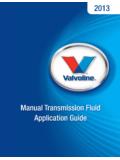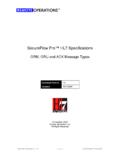Transcription of Cash Management 2005 - BAI
1 Cash Management Balance Reporting Specifications Version 2 Technical reference Manual 10/2005 Printed in the United States of America Copyright 2005 by BAI, Chicago, Illinois All rights reserved. No part of this publication may be reproduced, stored in a retrieval system, or transmitted in any form or by any means electronic, mechanical, photocopying, recording or other without the written permission of the publisher. The material in this publication was believed to be accurate at the time it was written. Due to the evolving nature of laws and regulations on this subject, BAI makes no guarantee as to the accuracy or completeness of the information contained in this publication. The material in this publication does not purport to be advice. If legal advice or other specialized services and knowledge are required, readers should seek a competent professional. Examples, including names and titles, are purely fictitious and are not intended to represent actual financial institutions or any real persons, living or dead.
2 United States copyright is not claimed on any material taken from the United States Government sources. Individuals who wish to use a portion of the material in any way should direct permission requests by mail to BAI Product Development, One North Franklin, Suite 1000, Chicago, IL 60606. For more information about BAI, visit our website at BAI is the financial services industry s leading professional organization focused on enhancing employee and organizational performance. Through ground-breaking research and an award-winning magazine, Banking Strategies, BAI provides the latest insights on complex, strategic issues in financial services. Through seminars, graduate schools and conferences including the industry s premier event, BAI s Retail Delivery Conference & Expo BAI reaches thousands of financial services professionals each year to deliver content designed around critical business needs and to facilitate vital connections between financial services professionals, industry experts and solutions providers.
3 Focusing on business issues and performance drivers, BAI applies its extensive line of training, metrics and employee assessments to help clients leverage their most important asset their employees. For more information, visit Table of Contents 1 Cash Management Balance An Overview of Balance 2 Balance Reporting Transmission Definitions of Uniform Type File Structure ..6 Record File Layout ..8 Record Characteristics ..9 3 Record Formats ..12 01 File Header ..12 02 Group 03 Account Identifier and Summary 16 Transaction 88 Continuation 49 Account 98 Group 99 File Trailer ..23 4 Data Account Control Amount ..25 As-of-Date Bank reference Block Customer Account Currency Customer reference File Control File Creation File Creation File Identification Funds Group Control Group Status ..32 Item Number of Number of Numbers of Originator Physical Record Receiver Record Sender Type Ultimate Receiver Version Number.
4 39 5 Implementing Cash Management Balance Reporting Operating Balance Reporting Implementation Appendix A Uniform BAI Balance Reporting Type Codes & Type Code Appendix B Currency Appendix C Glossary ..83 Appendix D Sample Appendix E BAI: Cash Management Balance Reporting 1 Cash Management Balance Reporting AN OVERVIE W OF BA LA NCE RE POR TIN G Volatile interest rates and attractive investment alternatives have caused major corporations to focus increased attention on cash Management . Banks have responded by offering services such as lockbox remittance processing, cash concentration, wire transfers, and controlled disbursement which help companies improve cash flow and utilize idle funds. Of equal importance are improvements in the delivery of information about a company s balances and transactions. The corporate treasurer s office must know the company s cash position to control usable funds effectively.
5 By closely monitoring cash position, the treasurer is better able to minimize idle cash balances assure appropriate liquidity take advantage of investment opportunities or reduce borrowings analyze and project funding needs Formerly, information needs were relatively simple. Data such as ledger balances, available balances, and breakdown of float were usually sufficient. However, there is a trend toward more extensive reporting, including intraday position information and greater transaction detail. This trend requires increasingly sophisticated reporting systems. When a company uses the services of only a few banks, telephone notification usually meets the treasurer s needs. But as the number of banking relationships increases, and as information requirements become more complex, the daily task of gathering information becomes more difficult and time-consuming. In response to corporate information needs, cash Management banks now offer automated balance reporting services.
6 Under automated reporting, the corporate customers ask each of their banks to report balance information to a central agent. The agent may be a bank, or it may be a third-party data processor. The corporate treasurer can then monitor banking relationships through a single data collection point. Many banks now offer automated reporting to an increasing number of companies. And the products themselves have become more sophisticated, allowing treasurers to manipulate and respond to the information as it is presented. Cash Management Balance Reporting 2 BAI: Cash Management Balance Reporting As reporting systems become more complex, differences in data formats can cause considerable difficulty. The Cash Management Balance Reporting Specifications establish a common format for exchanging data. By establishing an efficient mechanism for communication among multiple parties, the specifications facilitate complete, accurate, and timely information reporting, and help reduce the cost of providing this service.
7 BAI: Cash Management Balance Reporting 2 Balance Reporting Transmission Files DEFINI TI ONS O F P AR TIES In its simplest form, cash Management balance reporting involves two parties: the customer and the depository institution. However, intermediaries, such as data processing firms and other banks, often relay the messages and may combine data from several sources into a single report for customer convenience. To avoid confusion when transmissions that involve a number of intermediaries are being described, the balance reporting specifications define the following relationships: Customer: A commercial depositor. Balance and transaction data are reported for accounts held by the customer. Originator: A depository financial institution. Data are reported for accounts held by the customer at the originator institution. Intermediary: Any party other than the customer or originator involved in a balance reporting transmission.
8 Sender: The processor that is transmitting a file containing balance reporting data. The sender may be an originator or an intermediary. Receiver: The processor receiving the file transmitted by the sender. The receiver may be an intermediary or the customer. Ultimate Receiver: The processor that receives the final transmission of balance reporting data in BAI format before it is translated into usable form. It may be a bank or a data processor that provides cash Management services to a customer. Or it may be the customer if balance reports are transmitted directly to the customer s computer system. In balance reporting transmission files, the parties are identified as follows: Domestic Financial Institutions: ABA/FRB routing and transit number, including the check digit. Foreign Financial Institutions: , CHIPS, or another mutually agreed upon identifier. Nonbank Processors: DUNS number. Balance Reporting Transmission Files 4 BAI: Cash Management Balance Reporting UNI FO RM TYPE C ODES Balance reporting transmissions include data describing hundreds of different types of account activity, ranging from securities transactions to lockbox deposits.
9 Each transaction, summary or balance classification has been assigned a uniform type code. The type code uniquely identifies the type of activity or balance being reported. Type codes are three-digit numbers used to identify the types of data reported. Codes are either Status, Summary or Detail. General usage rules are as follows: Account Status: These codes describe the status of the account (for example, ledger balance, available balance and float position). Account Status type codes may only be used in the 03 record and associated Continuation (88) records. (See Record Descriptions for more information.) Status amounts may be positive or negative. Status type codes may not be accompanied by an item count or a funds type distribution. Only one amount for any Status type code can remain on file for a given As-of-Date for a given account. Activity Summary: These codes summarize account credit and debit activity (for example, total lockbox credits or total security debits) and may only be used in the 03 record and associated Continuation (88) records.
10 Summary amounts are always positive or unsigned. Summary type codes may be accompanied by an item count or funds type distribution. Only one amount for any Summary type code can remain on file for a given As-of-Date for a given account. Transaction Detail: These codes detail individual credits and debits (for example, individual lockbox deposit or foreign exchange debit) and may only be used in the 16 record. Detail amounts are always positive or unsigned. An account file may contain several Transaction Details with the same type code for a given As-of-Date. Only one amount for each Status or Summary type code can remain on file for each account on a given day. However, many Transaction Details may be on file with the same type code. The originator has the responsibility to ensure that only valid type codes are used in all transmissions . Receivers may, at their discretion, reject transmissions that include invalid type codes.



